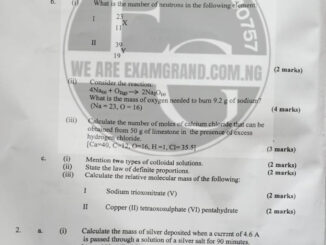
NECO 2023 ANIMALS HUSBANDRY PRACTICAL ANSWERS ;-ExamgrandComNg ✍🏻
ANIMAL HUSBANDRY (PRACTICAL) ANSWERS
(1a)
Specimen A – Heart of a cattle
Specimen B – shank (leg) of a fowl
Specimen C – Gizzard
Specimen D – Small intestine of goat
(1b)
(PICK ANY FOUR)
(i) Size: The heart of a cattle is relatively large compared to other organs.
(ii) Shape: It has a conical shape with a pointed apex.
(iii) Color: It is generally pinkish brown in color.
(iv) Weight: The average weight of the heart of a cattle is around 500-700 grams.
(v) Texture: It has a smooth, yet firm texture.
(vi) Structure: It has four chambers, each with its own distinct purpose and is divided into several sections.
(vii) Position: It is located in the chest cavity, in the center of the ribcage.
(1c)
(PICK ANY TWO)
(i) Feeding: Provide a balanced diet and high-quality feed to the animals to promote growth.
(ii) Exercise: Allow the animals to exercise regularly as it helps to build muscle and increase weight.
(iii) Vaccination: Make sure the animals are regularly vaccinated against common diseases and parasites that can reduce their weight.
(iv) Parasite Control: Control parasites such as lice, fleas, and mites to ensure they do not impede the animal’s growth.
(1d)
The difference in function between Specimen C (Gizzard) and D (small intestine of goat) is that the gizzard grinds food whereas the small intestine is responsible for absorption of nutrients.
(1e)
(PICK ANY FOUR)
(i) Trypsin
(ii) Chymotrypsin
(iii) Peptidases
(iv) Amylase
(v) Maltase
(vi) Lactase
(1f)
-Specimen A-
(PICK ANY ONE)
(i) It pumps blood throughout the body, providing oxygen and nutrients to the cells.
(ii) It helps to regulate the body temperature, by pumping hot and cold blood to different parts of the body.
(iii) Its strong muscles help to filter impurities and waste material from the blood.
(iv) It produces hormones and other chemicals that keep the body in balance.
-Specimen B-
(PICK ANY ONE)
(i) It provides the bird with the necessary propulsion to move and fly.
(ii) Its structure also helps birds to perform activities such as preening and bathing.
(iii) It helps to provide protection from external parasites and injury.
(iv) It also acts as an anchor during flight to support the wings and maintain balance.
-Specimen C-
(PICK ANY ONE)
(i) It breaks down food into smaller pieces for easier digestion.
(ii) It helps to extract minerals from food which are then absorbed by the body.
(iii) It eliminates waste materials from the gut.
(iv) It helps the bird to acquire essential vitamins and nutrients from its food.
-Specimen D-
(PICK ANY ONE)
(i) It absorbs broken down nutrients from the food into the bloodstream.
(ii) It helps to break down fats and proteins.
(iii) It eliminates waste products from the gut.
(iv) It produces enzymes and hormones needed for digestion and absorption.
•••••••••••••••••••••••••••••••••••••••••••••••••
(2a)
Specimen E – guinea grass
Specimen F – Stylo plant
Specimens G – blood meal
(2b)
Specimen E (guinea grass) – Panicum maximum.
Specimen F – (Stylo plant) – Stylosanthes guianensis.
(2c)
-Specimen E-
(PICK ANY ONE)
(i) It is a leafy perennial grass.
(ii) Its stems are flat and thin.
(iii) The leaves are long and narrow.
(iv) Its root system is shallow and fibrous.
-Specimen F-
(PICK ANY ONE)
(i) It is an erect, short-lived perennial herb.
(ii) Its stems are angular and hairy.
(iii) Its leaves are linear to oblong.
(iv) Its root system is deep and branching.
(2d)
Specimen E – by seed.
Specimen F – by cuttings or stem cuttings.
(2e)
Specimen E – protein.
Specimen F – phosphorus.
(2f)
(PICK ANY TWO)
(i) Freezing
(ii) Drying
(iii) Canning
(iv) Fermenting
(v) Pickling
(2g)
(i) Collecting the raw material
(ii) Pre-treatment of the raw material (grinding, mixing with water, etc.)
(iii) Heat treatment to eliminate harmful bacteria
(iv) Cooling and packaging
(2h)
(PICK ANY THREE)
(i) Lack of essential nutrients needed for efficient ruminal fermentation.
(ii) Oxidation of the fat content which reduces its nutritional value.
(iii) High nitrogen content which can cause digestive problems in livestock.
(iv) Bacterial contamination may occur due to improper handling.
(v) Poor palatability which reduces intake.
(vi) High cost
••••••••••••••••••••••••
(3a)
Specimen H – Live hen
(3b)
(PICK ANY FOUR)
(i) Avian Influenza (Bird Flu)
(ii) Newcastle Disease
(iii) Infectious Bronchitis
(iv) Infectious Laryngotracheitis
(v) Avian Mycoplasma Gallisepticum (MG)
(vi) Avian Encephalomyelitis
(vii) Blackhead Disease
(3c)
(PICK ANY FOUR)
(i) Nasal discharge
(ii) Coughing/gasping
(iii) Difficulty breathing
(iv) Sneezing/Sporadic breathing
(v) Runny eyes/nose
(vi) Decreased egg production and size
(vii) Increased mortality
(3d)
(i) Newcastle Disease Virus
(ii) Infectious Bronchitis Virus
(iii) Infectious Bursal Disease Virus
(iv) Escherichia coli bacterin
(3e)
(i) Newcastle Disease Virus – Intranasal
(ii) Infectious Bronchitis Virus – Intranasal/Oral
(iii) Infectious Bursal Disease Virus – Intramuscular/Subcutaneous Injection
(iv) Escherichia coli bacterin – Subcutaneous injection
(3f)
(i) Indian Rivers
(ii) White Leghorn
(iii) Kadaknath
••••••••••••••••••••••••••••••
COMPLETED✅





Be the first to comment